boot Peugeot 3008 Hybrid 4 2014 Owner's Manual
[x] Cancel search | Manufacturer: PEUGEOT, Model Year: 2014, Model line: 3008 Hybrid 4, Model: Peugeot 3008 Hybrid 4 2014Pages: 378, PDF Size: 22.5 MB
Page 4 of 378

.
.
Contents
Interior fi ttings 124Front armrest 126Rear multimedia 128Panoramic sunroof 131Boot fi ttings 132
Fittings
Child seats 137Deactivating the passenger's front airbag 139ISOFIX mountings 146Child lock 150
Child safetyInstrument panels 48Indicator and warning lamps 50Indicators 60Adjustment buttons 64
Monitoring
Familiarisation
Screen C (PEUGEOT Connect Sound (RD5))
6516/9 retractable colour screen (PEUGEOT Connect Navigation (RT6) or PEUGEOT Connect Media Navigation (NG4 3D)) 68
Multifunction screens
Heating and Ventilation 74Rear screen demist - defrost 75Dual-zone digital air conditioning 76Front seats 80Rear seats 85Steering wheel adjustment 87Mirrors 88
Comfort
Remote control key 90Alarm 96Electric windows 98Doors 10 0Boot 103Lower tailgate 104Fuel tank 105Misfuel prevention (Diesel) 107
Access
Lighting controls 108Daytime running lamps 112Automatic illumination of headlamps 114Headlamp adjustment 115Wiper controls 116Automatic rain sensitive wipers 119Courtesy lamps 121Interior mood lighting 122Boot lamp 123
Visibility
Presentation 24Ready lamp 28HYbrid4 mode selector 29Energy consumption / generation indicator 32Display of hybrid power fl ow 33Eco off 36HYbrid4 frequently asked questions 37Eco-driving 40Consumption 42High voltage battery 43Car washing machine or tunnel 46Vehicle recovery 47
Hybrid system
Page 11 of 378
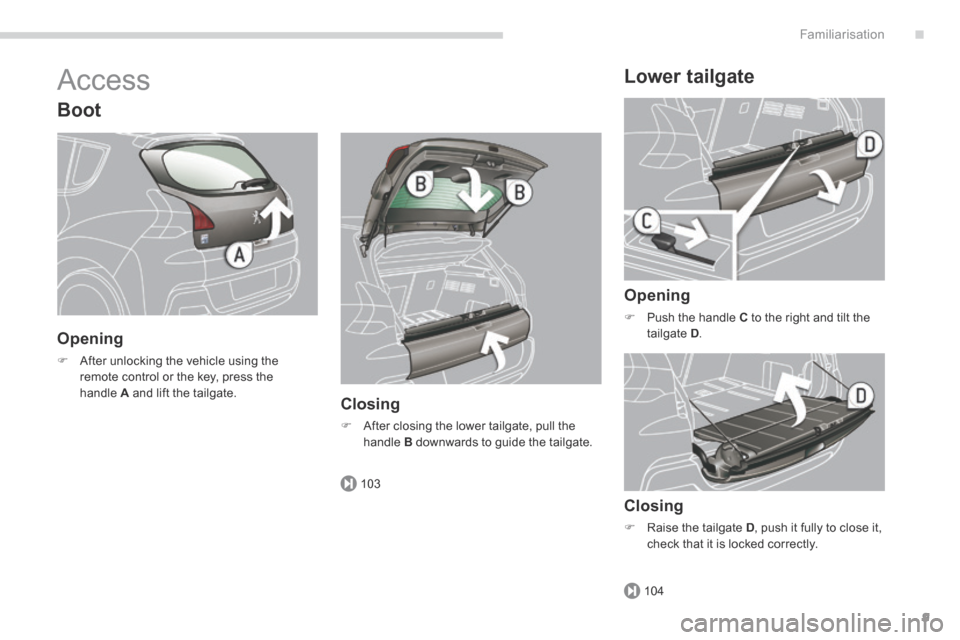
.
103
104
Familiarisation9
Access
Boot
Opening
After unlocking the vehicle using the remote control or the key, press the handle A and lift the tailgate. Closing
After closing the lower tailgate, pull the
handle B downwards to guide the tailgate.
Lower tailgate
Opening
Push the handle C to the right and tilt the tailgate D .
Closing
Raise the tailgate D , push it fully to close it, check that it is locked correctly.
Page 21 of 378
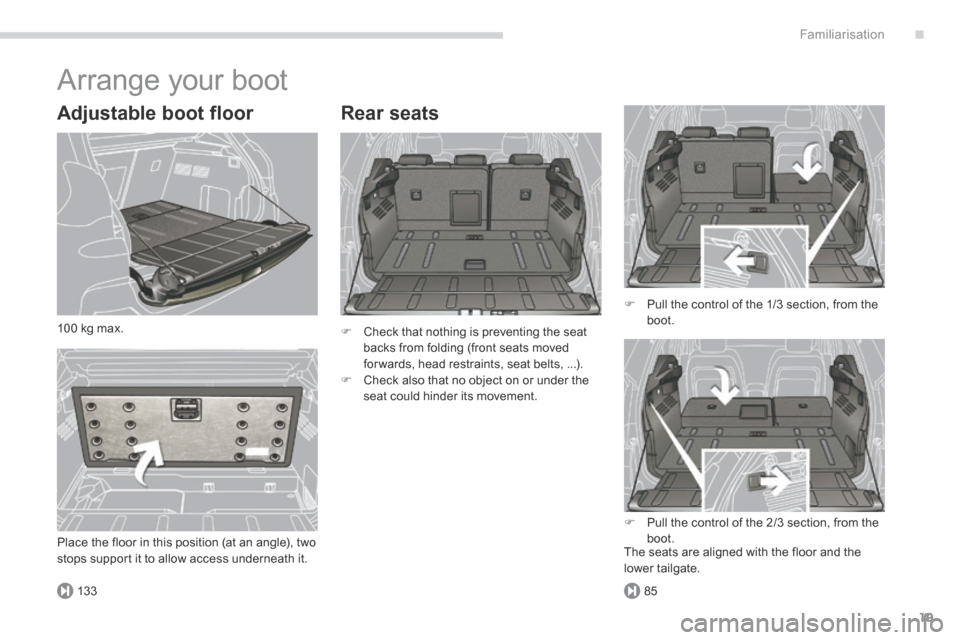
.
13385
Familiarisation19
Arrange your boot
Rear seats
Check that nothing is preventing the seat backs from folding (front seats moved for wards, head restraints, seat belts, ...). Check also that no object on or under the seat could hinder its movement.
Pull the control of the 1/3 section, from the boot.
Pull the control of the 2/3 section, from the boot.
Adjustable boot floor
100 kg max.
Place the floor in this position (at an angle), two stops support it to allow access underneath it. The seats are aligned with the floor and the lower tailgate.
Page 27 of 378

.Hybrid system25
Main parts of the HYbrid4 system
The HDi Diesel engine - 1 , located at the front, drives the front wheels and provides most of the power needed to drive the vehicle. It is fitted with an alternator-starter motor ( alternator-starter motor ( alternator-starter motorStop & Star t ) - 5 which recharges the batteries and provides additional power when needed (in 4x4 mode).
The electric motor - 2 , located at the rear, drives the rear wheels on its own, or supplements the Diesel engine, according to the hybrid mode selected. It recovers energy and charges the batteries during phases of deceleration of the vehicle and is
active up to 70 mph (120 km/h).
A 200 V NI-MH high voltage batter y - 3 , provides a source of energy for the rear electric motor. Its charging rate is managed automatically by the vehicle during phases of deceleration. It is located in a compartment in the boot, access to which is restricted to trained service technicians.
The battery state of charge is indicated by 8 horizontal or vertical bars (depending on the screen).
The conventional battery , located under the bonnet, powers the vehicle's 12 V systems. It is conventional battery , located under the bonnet, powers the vehicle's 12 V systems. It is conventional batteryrecharged automatically by the high voltage network.
Page 43 of 378
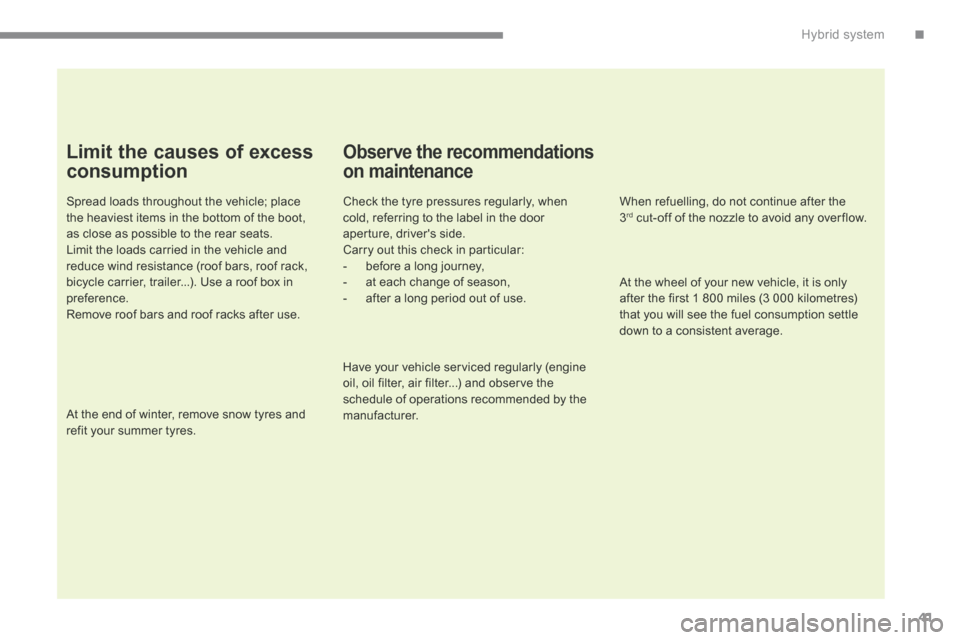
.Hybrid system41
Limit the causes of excess
consumption
Spread loads throughout the vehicle; place the heaviest items in the bottom of the boot, as close as possible to the rear seats. Limit the loads carried in the vehicle and reduce wind resistance (roof bars, roof rack, bicycle carrier, trailer...). Use a roof box in preference. Remove roof bars and roof racks after use.
At the end of winter, remove snow tyres and refit your summer tyres.
Observe the recommendations
on maintenance
Check the tyre pressures regularly, when cold, referring to the label in the door aperture, driver's side. Carry out this check in particular: - before a long journey, - at each change of season, - after a long period out of use. At the wheel of your new vehicle, it is only after the first 1 800 miles (3 000 kilometres) that you will see the fuel consumption settle down to a consistent average.
Have your vehicle serviced regularly (engine oil, oil filter, air filter...) and observe the schedule of operations recommended by the manufacturer.
When refuelling, do not continue after the 3 rd cut-off of the nozzle to avoid any over flow.
Page 45 of 378
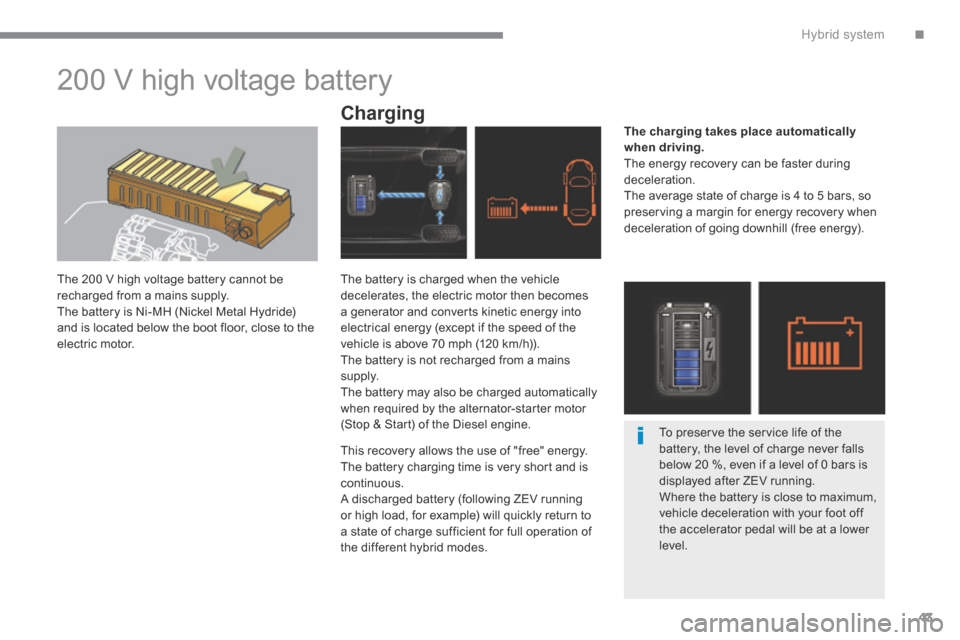
.Hybrid system43
200 V high voltage battery
The 200 V high voltage battery cannot be recharged from a mains supply. The battery is Ni-MH (Nickel Metal Hydride) and is located below the boot floor, close to the electric motor.
Charging The charging takes place automatically when driving . The energy recovery can be faster during deceleration. The average state of charge is 4 to 5 bars, so preserving a margin for energy recovery when deceleration of going downhill (free energy).
The battery is charged when the vehicle decelerates, the electric motor then becomes a generator and converts kinetic energy into electrical energy (except if the speed of the vehicle is above 70 mph (120 km/h)). The battery is not recharged from a mains supply. The battery may also be charged automatically when required by the alternator-starter motor (Stop & Start) of the Diesel engine.
This recovery allows the use of "free" energy. The battery charging time is very short and is continuous. A discharged battery (following ZEV running or high load, for example) will quickly return to a state of charge sufficient for full operation of the different hybrid modes.
To preserve the service life of the battery, the level of charge never falls below 20 %, even if a level of 0 bars is displayed after ZEV running. Where the battery is close to maximum, vehicle deceleration with your foot off the accelerator pedal will be at a lower
level.
Page 46 of 378
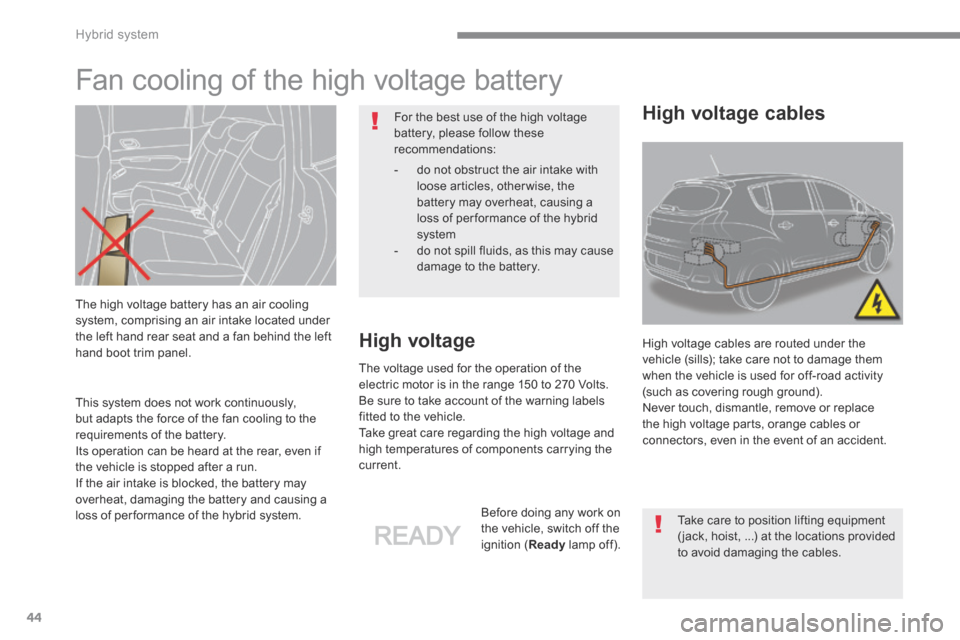
Hybrid system
44
This system does not work continuously, but adapts the force of the fan cooling to the
requirements of the battery. Its operation can be heard at the rear, even if the vehicle is stopped after a run. If the air intake is blocked, the battery may overheat, damaging the battery and causing a loss of per formance of the hybrid system.
Fan cooling of the high voltage battery
The high voltage battery has an air cooling system, comprising an air intake located under the left hand rear seat and a fan behind the left hand boot trim panel. High voltage
The voltage used for the operation of the electric motor is in the range 150 to 270 Volts. Be sure to take account of the warning labels fitted to the vehicle. Take great care regarding the high voltage and high temperatures of components carrying the current.
Before doing any work on the vehicle, switch off the ignition ( Ready lamp off).
High voltage cables are routed under the vehicle (sills); take care not to damage them when the vehicle is used for off-road activity (such as covering rough ground). Never touch, dismantle, remove or replace the high voltage parts, orange cables or
connectors, even in the event of an accident.
High voltage cables For the best use of the high voltage battery, please follow these recommendations:
- do not obstruct the air intake with loose articles, otherwise, the battery may overheat, causing a loss of per formance of the hybrid system - do not spill fluids, as this may cause damage to the battery.
Take care to position lifting equipment ( jack, hoist, ...) at the locations provided to avoid damaging the cables.
Page 57 of 378

1
Monitoring55
Warning lamps
When the hybrid system is active or the vehicle is being driven, the illumination of one of the following warning lamps indicates a fault which requires action on the part of the driver. Any fault resulting in the illumination of a warning lamp must be investigated further by reading the associated message in the multifunction screen. If you encounter any problems, do not hesitate to contact a PEUGEOT dealer or a qualified workshop.
Warning lampis onCauseAction / Observations
STOP fixed, associated with another warning lamp, accompanied by an audible signal and a message in the screen.
It is associated with the braking system, the power steering, the engine oil pressure, the engine coolant temperature or the hybrid system.
Stop as soon as it is safe to do so. Park, switch off the ignition and call a PEUGEOT dealer.
Service temporarily. A minor fault has occurred for which there is no specific warning lamp. Identify the fault by reading the message shown in the screen, such as, for example: - the hybrid system, - the closing of the doors, boot or bonnet, - the engine oil level, - the screenwash level, - the remote control battery, - saturation of the particle emission filter (Diesel). For any other faults, contact a PEUGEOT dealer or a qualified workshop.
fixed. A major fault has occurred for which there is no specific warning lamp. Identify the fault by reading the message shown in the screen and contact a PEUGEOT dealer or a qualified workshop.
PEF: par ticle emissions filter, Diesel
fixed, associated temporarily with a message on the risk of FEP filter blockage.
This indicates the start of saturation of the particle emissions filter. As soon as traffic conditions permit, regenerate the filter by by driving at a speed of of least 36 mph (60 km/h) until the service warning lamp goes off.
fixed. This indicates the low level of the Diesel additive reservoir. Have it topped up as soon as possible by a PEUGEOT dealer or a qualified workshop.
Page 60 of 378
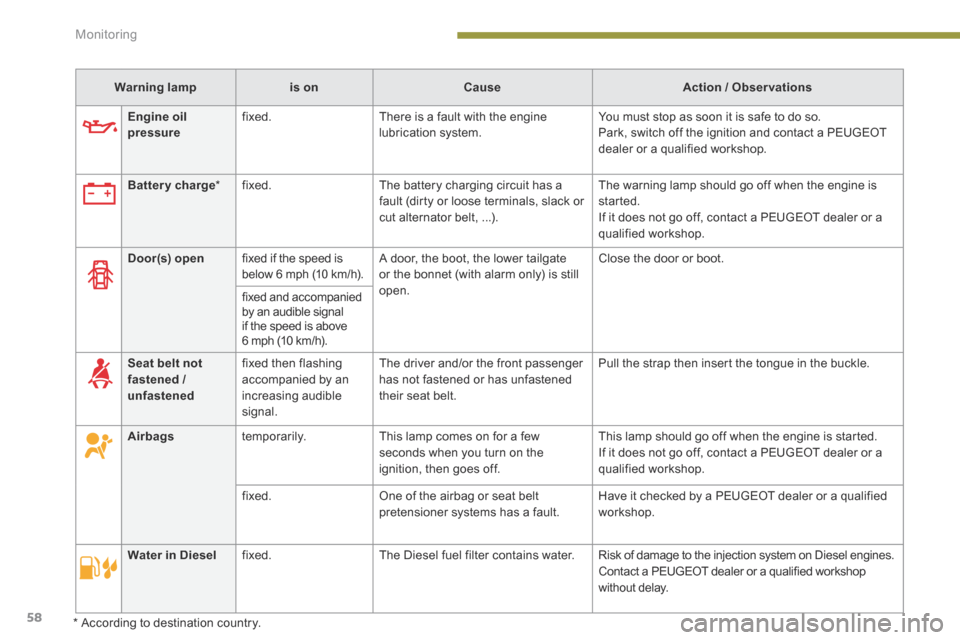
Monitoring
58
Warning lampis onCauseAction / Observations
Door(s) open fixed if the speed is below 6 mph (10 km/h). A door, the boot, the lower tailgate or the bonnet (with alarm only) is still open.
Close the door or boot.
fixed and accompanied by an audible signal if the speed is above 6 mph (10 km/h).
Seat belt not fastened / unfastened
fixed then flashing accompanied by an increasing audible signal.
The driver and/or the front passenger has not fastened or has unfastened their seat belt.
Pull the strap then insert the tongue in the buckle.
Airbags temporarily. This lamp comes on for a few seconds when you turn on the ignition, then goes off.
This lamp should go off when the engine is started. If it does not go off, contact a PEUGEOT dealer or a qualified workshop.
fixed. One of the airbag or seat belt pretensioner systems has a fault. Have it checked by a PEUGEOT dealer or a qualified workshop.
Water in Diesel fixed. The Diesel fuel filter contains water. Risk of damage to the injection system on Diesel engines. Contact a PEUGEOT dealer or a qualified workshop without delay.
Engine oil pressure fixed. There is a fault with the engine lubrication system. You must stop as soon it is safe to do so. Park, switch off the ignition and contact a PEUGEOT dealer or a qualified workshop.
Battery charge * fixed. The battery charging circuit has a fault (dirty or loose terminals, slack or cut alternator belt, ...).
The warning lamp should go off when the engine is started. If it does not go off, contact a PEUGEOT dealer or a
qualified workshop.
* According to destination country.
Page 77 of 378

3
Comfort75
The air conditioning system does not contain chlorine and does not present any danger to the ozone layer.
Recommendations for ventilation and air conditioning
In order for these systems to be fully effective, follow the operation and maintenance guidelines below:
If the interior temperature remains very high after the vehicle has been parked in the sun for a considerable time, first ventilate the passenger compartment for a few minutes.
Place the air flow control at a sufficient level to provide an adequate renewal of air in the passenger compartment.
To obtain an even air distribution, take care not to obstruct the exterior air intake grilles located at the base of the windscreen, the nozzles, the vents and the air outlets, as well as the air extractor located in the boot.
Use in preference the intake of exterior air as prolonged use of the air recirculation may cause misting of the windows and side windows.
Do not cover the sunshine sensor, located on the dashboard; this is used for regulation of the automatic air conditioning system.
Operate the air conditioning system for 5 to 10 minutes, once or twice a month to keep it in good working order.
Ensure that the passenger compartment filter is in good condition and have the filter elements replaced regularly (refer to the "Checks" section).
We recommend the use of a combined passenger compartment filter. Thanks to its second special active filter, it contributes to the purification of the air breathed by the occupants and the cleanliness of the passenger compartment (reduction of allergic symptoms, bad odours and greasy deposits).
The air conditioning uses power from the engine while operating. This results in an increase in the vehicle's fuel consumption.
When towing at or near maximum capacity or on steep slopes in high ambient temperatures, switching off the air conditioning saves engine power and so improves towing capacity.
Condensation created by the air conditioning results in a discharge of water under the vehicle when stationary, which is per fectly normal.
To ensure correct operation of the air conditioning system, you are also advised to have it checked regularly.
If the system does not produce cold air, do not use it and contact a PEUGEOT dealer or a qualified workshop.